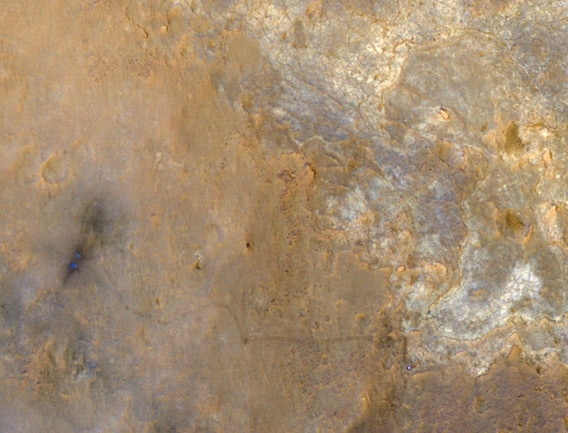Create a free profile to get unlimited access to exclusive videos, sweepstakes, and more!
Mars Probe Sees Other Mars Probe on Mars

There are times I sit back and wonder that we do the things we do. This picture, just released by NASA, triggered one of those moments: It shows the landing site, wheel tracks, and Curiosity rover itself on the surface of Mars, seen by another spacecraft orbiting the red planet!
Incredible! The camera that took this shot was HiRISE (High Resolution Imaging Science Experiment), one of my favorite detectors in space. Itâs on the Mars Reconnaissance Orbiter, which has been circling Mars since March 2006. The camera has a pretty good telescope on it and can resolve objects on the surface less than 1 meter across.
The Curiosity rover is about 3 meters long, so itâs easily visible in HiRISE images. Its wheels are 50 centimeters across and a little less than that wide, so the tracks are visible as well. The rockets used in the last moments before the rover landed on the surface blew the dust and surface material around, so that blast pattern (which looks blue in this color-enhanced shot) is easily seen in the image, too. I annotated it to make this all clear:
The tracks are a little over 3 meters (10 feet) apart, to give you a sense of scale. At this point, the rover had traveled about 1 kilometer (0.6 miles) from its landing site. On July 21, it took its longest jaunt yet, traveling about 100 meters in a single drive. Its eventual goal is Mt. Sharp (technically, Aeolis Mons), which is roughly 8 kilometers (5 miles) from the roverâs location.
Engineers have been cautious about moving Curiosity around but will soon take it on even longer drives. Eventually, its auto-navigation system will be used, allowing the rover to go beyond routes deemed safe by looking at previous images; essentially the destination can be programmed in, and the rover will find the best path to get there itself.
Pretty amazing. And no less astonishing is the fact that we can see it from space, using an orbiter that had already been at Mars for six years when Curiosity landed! Then again, the bar for âamazingâ is set pretty high when you have a 1-ton laser-eyed nuclear-powered mobile chemistry lab on another world in the first place.


























